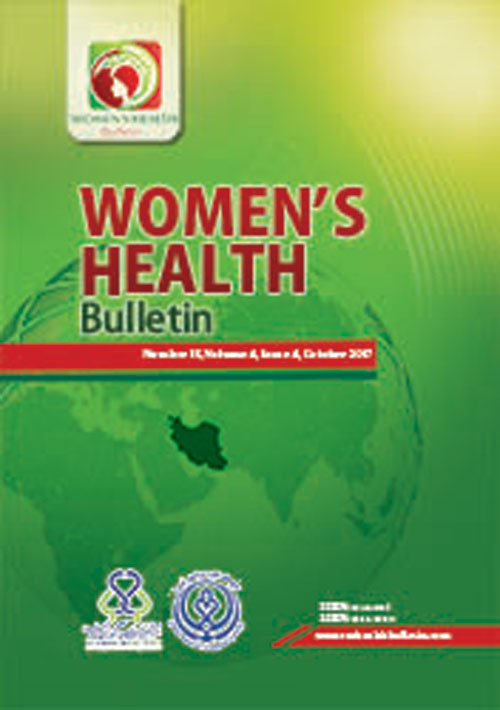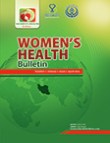فهرست مطالب

Women’s Health Bulletin
Volume:6 Issue: 2, Apr 2019
- تاریخ انتشار: 1398/02/21
- تعداد عناوین: 6
-
-
Page 1ObjectivesThe aim of this study was to evaluate the effect of peripheral heart action (PHA) and yoga exercises on respiratory functions and CRP of obese postmenopausal women.MethodsIn this quasi-experimental study, 40 elderly women (age: 65.3 ± 2.6 years) referring voluntarily to the Sport Counseling Center of Sports and Youth Administration of Qazvin province in 2018 were randomly assigned to three groups: yoga exercise group (n = 14), strength training group (n = 13), and control group (n = 13). The experimental groups performed the exercise protocols (yoga and PHA training) three sessions a week each lasting 40 minutes for two months. Tests were performed to evaluate the subjects’ ventilatory capacity including FVC and FEV1 using spirometry and CRP. The tests were done in pre-test and post-test. Data were analyzed by SPSS software using t-test, one-way ANOVA, and Tukey post hoc test.ResultsFEV1 was better in the yoga and PHA exercise groups than in the control group (P = 0.001 and P = 0.016, respectively). Furthermore, CRP was better in the yoga and PHA training groups than in the control group (P = 0.001 and P = 0.02, respectively). There was no significant difference in the study variables between the two training groups (P = 0.97).ConclusionsBased on the obtained results, due to the vulnerability of the elderly to cardiorespiratory and inflammatory problems, it is highly proposed to apply such exercises to improve the physiological functions.Keywords: Respiratory Functions, Yoga, Peripheral Heart Action Exercise, Inflammatory Index
-
Page 2Socio-economic factors, in addition to value and attitude changes, have had a major impact on fertility behavior of women toward childbearing. The main purpose of this study is to investigate childbearing desire of 6183 women in provinces with total fertility rate (TFR) lower (TFR ≤ 2) and upper (TFR > 2) than replacement level by classification and regression trees (CART) algorithm, as one of the most applicable classification trees. In this study women’s job, place of residence, age, opinion, marriage age, educational level, and children ever born were investigated as predictors. The accuracy of fitted classification trees for CD in provinces with TFR ≤ 2 and TFR > 2 were 0.68 and 0.72, respectively. As a result, women’s children ever born and age had significant roles on their desire to have a child in all provinces while their opinion toward childbearing had just effect on provinces with TFR ≤ 2. In provinces with TFR ≤ 2, 10 - 39 years old women with 2 children and less CEB were willing to have another child. Women with 2 or less children at the age of 10 - 29 as well as women with 3 or more than 3 children at the age of 20 - 29 had a desire for more children in provinces with TFR > 2. If the women have a positive attitude toward childbearing and their age is not high, they will desire to give birth to a child until they reach the ideal number of their children. Thus, policies in changing their attitudes toward childbearing and creating the necessary facilities to prevent delays in marriage could be an important step in changing fertility rates.Keywords: Total Fertility Rate, Childbearing Desire, Classification, Regression Trees (CART)
-
Page 3ObjectivesThis study aimed to investigate the effect of resistance training in water and land with vitamin D on anti-Mullerian hormone in women with polycystic ovary syndrome (PCOS).MethodsSixty women with PCOS (20 - 35 years old) referred to the Hafez Hospital in Shiraz in 2018 were selected and randomly divided into six groups of (1) control, (2) water training, (3) land training, (4) vitamin D, (5) water training with vitamin D, and (6) land training with vitamin D. Groups 2, 3, 5, and 6 performed resistance training in water and land for eight weeks, three sessions per week, while groups 4, 5 and 6 consumed vitamin D for eight weeks. For statistical analysis of data independent samples t-test, one-way ANOVA and Tukey’s post hoc tests were used (P ≤ 0.05).ResultsTraining in water and land have no significant effect on anti-Mullerian hormone (P ≥ 0.05); vitamin D, training in water with vitamin D, and training in land with vitamin D have significant effect on reduction of anti-Mullerian hormone (P = 0.001); training in water with vitamin D and training in land with vitamin D have more effect on reduction of anti-Mullerian hormone rather than vitamin D (P ≤ 0.05) and after training in water with vitamin D (P = 0.01) and training in land with vitamin D (P = 0.001) there is a significant relationship between anti-Mullerian hormone changes and weight.ConclusionsIt appears that resistance training in water and land combined with vitamin D consumption may decrease the anti-Mullerian hormone by reduction in weight and as a result improve ovarian and reproductive function in women with PCOS.Keywords: Fertility Disorder, Anti-Mullerian, Training, Vitamin D
-
Page 4BackgroundIran is among the countries located on the thalassemia gene belt. Approximately one-fourth of new thalassemia cases in Iran live in Sistan and Baluchestan Province. The employment of appropriate family planning methods in couples carrying thalassemia gene is one of the major preventive strategies.ObjectivesThe present study aimed at examining the determinants of contraceptive use in women of reproductive age who have children with thalassemia major living in Sistan and Baluchestan Province, Iran.MethodsThe current cross sectional study was conducted on 150 women of reproductive age having children with thalassemia major in Sistan and Baluchestan Province. Data were collected from the thalassemia units of three hospitals in Zahedan, Iranshahr, and Chabahar cities from 2017 to 2018. Data collection tool was a researcher-made questionnaire consisted of three parts: the cover letter, items on the socioeconomic status and demographic characteristics, as well as questions about contraception use. SPSS version 20 was employed to analyze data. Pearson chi-square, two-sample t-test, and enter and backward logistic regression were employed to analyze the study data.ResultsConcerning knowledge about contraceptives, 16.4% of respondents were not familiar with any contraception methods. Additionally, 49.3% of the women said that they did not use any contraception methods and about 8% of users did not benefit from safe methods. Results of chi-square/t-tests indicated significant differences between users and nonusers of contraceptives in terms of ethnicity, women’s age, spousal age difference, couple education level, place of residence, polygamy, the desired number of children, distance from health center, and knowledge about contraceptives. Enter and backward logistic regression results also revealed that spousal age difference (odds ratio (OR) = 0.914, P < 0.001), place of residence (OR = 7.68, P < 0.001), and polygamy (OR = 0.127, P < 0.001) were the main predictors of contraceptive use.ConclusionsDespite Iran’s success in lowering thalassemia births, socioeconomic and cultural factors contribute to the risk of new birth with thalassemia major among couples with minor thalassemia in Sistan and Baluchestan Province.Keywords: Thalassemia, Thalassemia Major, Contraception, Family Planning, Sistan, Baluchestan Province
-
Page 5BackgroundConsidering the significance of morality and the need to understand its determinants, as well as the growing tendency toward dealing with psychological variables as latent variables as they are in the real world, it is not surprising that in the moral psychology area, classical statistical methods are being replaced by new psychological methods to take an effective step to raise the knowledge in this area.ObjectivesThe aim of this study was to propose a structural equation model to investigate the predicting role of female students’ self-regulation in moral identity as latent variables.MethodsThe sample of this study included 361 female students of the University of Mazandaran in the 2017 - 2018 academic year selected through stratified random sampling. The participants completed the short version of the Self-Regulation Inventory and the Moral Identity Questionnaire. The obtained data were analyzed by SPSS (v.24) and AMOS (v. 24) using structural equation modeling.ResultsAfter confirming the validity of the scales used to explain the latent variables, i.e. self-regulation and moral identity, it was observed that female students’ self-regulation was a significant predictor of moral identity (β = 0.69, P < 0.001).ConclusionsAccording to the study, increasing self-regulation in female students is accompanied by increasing their moral identity.Keywords: Self-regulation, Moral Identity, Structural Equation Modeling, Modeling, Female Students
-
Page 6BackgroundHepatitis C virus (HCV) is a public health issue, worldwide. HCV infection during pregnancy is associated with vertical transmission.ObjectivesThe current study aimed at investigating the prevalence of HCV in pregnant women.MethodsThe current cross sectional study was conducted in Duhok, Kurdistan region of Iraq from January 2016 to December 2018. In the study, pregnant women were tested for HCV antibodies (HCV-Ab) positivity. The infection then was confirmed by HCV-real time polymerase chain reaction (RT-PCR).ResultsDuring the study, 37,200 pregnant women were recruited; 15 (0.04%) subjects were positive for HCV-Ab. To confirm the infection, HCV-RT PCR was performed for subjects with positive results and only three cases were confirmed using this method; giving a prevalence of 3/37,200 (0.001%).ConclusionsHCV prevalence in pregnant women was low in Duhok city. Continuous screening is required to control infection and prevent vertical transmission.Keywords: HCV, Pregnancy, Prevalence, Iraq, Duhok, Kurdistan


